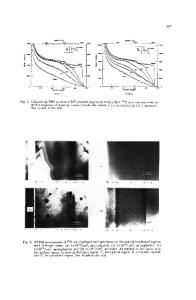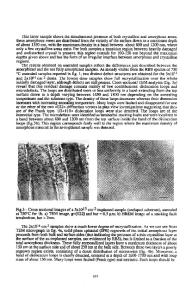Optical Activity of Yb 3+ in MeV Ion-Implanted InP.
- PDF / 325,668 Bytes
- 6 Pages / 414.72 x 648 pts Page_size
- 78 Downloads / 314 Views
OPTICAL ACTIVITY OF Yb 3* IN MeV ION-IMPLANTED InP.
S. Uekusa*, A. Majima*, H. Katsumata*, Y. Noyori*, and M. Kumagai** *Meiji University, Kawasaki, Kanagawa, 214 Japan **Kanagawa High-Technology Foundation, Kawasaki, Kanagawa, 214 Japan.
ABSTRACT
For the evaluation of an implanted layer, photoluminescence (PL) and photoluminescence excitation (PLE) measurements, which are nondestructive and sensitive methods for identifying impurities and 3 defects, were performed. Yb +-related sharp luminescence was observed at a wavelength of 1002nm, due to the transitions which occurred between the spin-orbit levels 2 F 5 / 2 --* 2F 7/2 of Yb 3 ÷ (4f 13 ). Most efficient 3 luminescence of Yb + was achieved at an excitation wavelength of around 880nm. The luminescence intensity of this peak (Yb 3 ÷) decreased with an increase in annealing temperature. Since the peak has not been observed for good samples in crystallinity, it may indicate that new, efficient energy transfer processes to rare-earth ions occur through the defect energy level. Especially, for the sample annealed at 600'C, Yb-related luminescence intensity excited by the photon energy below the band gap is about 3 times larger than that of excited by the photon energy above the band gap.
INTRODUCTION
The optical behavior of rare-earth (RE)-doped III-V compound semiconductors, such as GaAs and InP, has been attractive because of its sharp and temperature-independent emission due to intra-4f-shell transition of RE [1]. These features are very important in optoelectronic device applications, e.g., light-emitting diodes and laser diodes. Among the RE ions in Ill-V compounds, Yb-doped InP has been one of the most extensively studied materials in studies of the luminescence mechanism [2], because this material has two characteristic properties. For one thing an energy level scheme of the Yb-4f-shell is simple with only one excited state, for another Yb intra-4f-shell luminescence spectrum does not depend on the sample preparation methods: This luminescence spectrum has been observed in samples grown by liquid phase epitaxy (LPE) [3], metalorganic chemical vapor phase epitaxy (MOCVD) [4], molecular beam epitaxy (MBE) [5], as well as ion implanted samples [6][7]. This suggests that the Yb atoms occupy only one type of lattice site in InP. Zeeman effect measurements have revealed that the Yb 3 ÷ in InP is in a site of Td symmetry, probably substituting indium [8]. Whitney et al. [9] have observed that Yb forms an acceptor-like electron trap (AE trap) level at 30meV below the bottom of the conduction band. According to their proposed excitation model, the Yb-4f-shell is excited by an Auger-type transfer of energy from the recombining electronhole pair at the AE trap. On the other hand, Kasatkin et al. [10] and Kibrber et al. [3] have proposed that the Yb-4f-shell is excited by the energy released through the recombination of donor-acceptor pair, and either by direct capture of an exciton or impact excitation by hot carriers, respectively. Mat. Res. Soc. Symp. Proc. Vol. 3
Data Loading...











